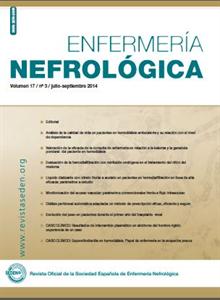Contenido del artículo principal
Resumen
es un objetivo capital en el paciente en hemodiálisis. Los parámetros clásicos de monitorización del acceso vascular son en general tardíos para la detección de estenosis. El cálculo del flujo intraacceso es un método de segunda generación que permite conocer el flujo sanguíneo máximo del acceso así como detectar estenosis ante una disminución del mismo. El objetivo de este estudio es valorar la eficacia de la medición y vigilancia del flujo intraacceso frente a los parámetros clínicos de primera generación.
Mensualmente se realiza monitorización del acceso vascular registrando variables del examen físico y del examen dinámico. La determinación de flujo intraacceso se realiza trimestralmente en FAV y mensualmente en PPTFE. Se indica realización de fistulografía si el flujo intraacceso es menor de 500ml/min o disminución en un 20% confirmado en dos tomas consecutivas, si hay variaciones en la exploración física y disminución = 25% de Kt, flujo sanguíneo o aumento de presiones venosas o recirculación.
Se realizan 61 fistulografías. Se hallan diferencias significativas por método de valoración (p<0,001) así como diferencias significativas en falsos positivos (fistulografía blanca o estenosis < 50%) (p=0,024).
La monitorización del flujo intraacceso es un método altamente sensible de detección de disfunción del acceso vascular. La combinación de parámetros clínicos, clásicos y el flujo intraacceso en un programa de monitorización del acceso vascular permite detectar más del 80% de los casos confirmados por fistulografía.
Mensualmente se realiza monitorización del acceso vascular registrando variables del examen físico y del examen dinámico. La determinación de flujo intraacceso se realiza trimestralmente en FAV y mensualmente en PPTFE. Se indica realización de fistulografía si el flujo intraacceso es menor de 500ml/min o disminución en un 20% confirmado en dos tomas consecutivas, si hay variaciones en la exploración física y disminución = 25% de Kt, flujo sanguíneo o aumento de presiones venosas o recirculación.
Se realizan 61 fistulografías. Se hallan diferencias significativas por método de valoración (p<0,001) así como diferencias significativas en falsos positivos (fistulografía blanca o estenosis < 50%) (p=0,024).
La monitorización del flujo intraacceso es un método altamente sensible de detección de disfunción del acceso vascular. La combinación de parámetros clínicos, clásicos y el flujo intraacceso en un programa de monitorización del acceso vascular permite detectar más del 80% de los casos confirmados por fistulografía.
Palabras clave
Acceso vascular; monitorización; vigilancia; flujo intracceso.
Detalles del artículo
Licencia
Aviso de derechos de autor/a
© Los autores ceden de forma no exclusiva los derechos de explotación de los trabajos publicados y consiente en que su uso y distribución se realice con la Licencia Creative Commons Atribución - No comercial 4.0 Internacional (CC BY-NC 4.0). Puede consultar desde aquí la versión informativa y el texto legal de la licencia. Esta circunstancia ha de hacerse constar expresamente de esta forma cuando sea necesario.
Cómo citar
1.
Fernández Martínez AV, Arregui Arias YV, Pérez Díaz R, Pérez Valencia L, Orenes Bernabé FJ, García Sánchez JL. Monitorización del acceso vascular: parámetros convencionales frente a flujo intraacceso. Enferm Nefrol [Internet]. 2014 [consultado 18 Dic 2025];17(3):[aprox. 4 p.]. Disponible en: https://www.enfermerianefrologica.com/revista/article/view/3699




